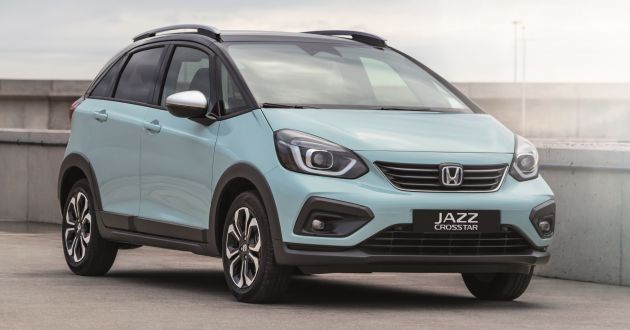Honda will debut the fourth-generation Jazz for the European market at next month’s 2020 Geneva Motor Show. Along with the regular B-segment hatchback, Honda will also be introducing the Jazz Crosstar for the continent.
In Japan, where it went on sale less than two weeks ago, the SUV-inspired Fit Crosstar is sold alongside the Basic, the more upmarket Home and the range-topping Luxe, the latter getting chrome accents and leather upholstery. The Ness is the “lifestyle” option. The latter and the Crosstar are offered with water-repellant fabric trim. There are also trim and colour differences, as detailed in our 2019 Tokyo Motor Show report.
Water-resistant upholstery aside, the Jazz Crosstar comes with increased ride height, integrated roof rails, a bolder front grille design, black cladding and side sills, and Crosstar-specific alloys. It will come with the same e:HEV two-motor hybrid powertrain as the regular Jazz.
Speaking of that, the hybrid variant will be the sole option for European Jazz buyers, in line with the brand’s electrification strategy. Honda says that the Jazz and the Honda e electric car are the first of six models to be launched that will see all Honda’s mainstream models in Europe electrified by 2022.
The e:HEV system comprises two compact electric motors connected to a 1.5 litre DOHC i-VTEC petrol engine, a lithium-ion battery and a fixed-gear transmission via an intelligent power control unit. One of the motors act as a generator to recharge the battery. The other is a propulsion motor to assist in low-speed acceleration.
Instead of a conventional transmission, the engine sends drive to the front wheels via a single fixed-gear ratio and a lock-up clutch, which is said to provide a smoother transfer of torque and a linear feel during acceleration. Honda says this setup is also more compact and refined when compared to a planetary eCVT gearbox usually associated with hybrids.
Total output is rated at 109 PS and 253 Nm of torque, which propels the car from 0-100 km/h in 9.4 seconds and a top speed of 175 km/h. CO2 emissions is rated at 102 g/km and fuel economy is rated at 4.5 litres per 100 km in the latest WLTP cycle (110 g/km and 4.8 litres per 100 km for the less aerodynamic Crosstar).
A power control unit selects from three interchangeable drive modes (EV Drive, Hybrid Drive, Engine Drive) automatically. In Hybrid Drive, excess power from the engine can also be diverted to recharge the battery via the generator motor. At highway speeds, Engine Drive is used, with the electric propulsion motor acting as an on-demand power boost for acceleration.
Despite the presence of the battery pack in the rear of the car, the Jazz retains its Magic Seat functionality and 1,203 litres of cargo capacity with the seats down, or 298 litres with them up. The monoform shape and the Jazz’s legendary packaging promises lots of space.
Malaysians are familiar with the Jazz, having had all three generations of the roomy hatch officially sold here. But word is that Honda will be coming up with a hatchback version of the current (upcoming for Malaysia) City, and it will be a change of form and format from the familiar high-roofed Jazz template. Check out the planned “City Hatchback” and tell us which do you prefer.
Source: Read Full Article


